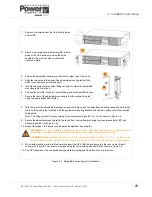
UPS725-02-02 PowerWave 1000 (4.5 - 10 kVA) User Manual UK Dated 13/03/15
9
2: General Description
2.3.3 Parallel system operation
Up to four PowerWave 1000 UPS modules can be connected in parallel for increased power capacity or redundancy
operation. A functional block diagram of a three module parallel system is shown in Figure 2.3.
A PowerWave 1000 UPS parallel system has a decentralised bypass architecture in that each UPS module contains its
own static switch and static bypass line. This eliminates the need for a separate bypass cabinet (as required by some
manufacturers’ systems) and so avoids a potential single point of failure.
In a multi-module parallel system, the topology and internal operation of each UPS module is identical to that described
previously for a stand-alone system. However, when operating as part of a parallel system it is critical that UPS control
functions such as load sharing, frequency synchronisation, and load transfer between UPS and bypass, are observed by
all the connected modules. In the PowerWave 1000 UPS system the ‘inter-module’ control functions are achieved using a
parallel control bus which takes the form of a ring network connected to all the modules in the system that allows the
modules to communicated with each other to properly share their control operation.
When a parallel system is installed, each module is assigned a numerical position within the parallel ring and the ‘first’
module is deemed to be the ‘master’ from which the other modules take their lead. If the ‘master’ module undergoes a
problem, or is shut down, the next highest available module in the ring will take over the ‘master’ role. This avoids a
potential single point of failure in the parallel chain and ensures the highest level of power availability.
Parallel system capacity expansion
Some applications present a low initial power demand which increases over time as the application grows; and it is
essential that the installed system can be expanded to meet the growing needs without compromising the existing load.
This situation is easily managed in a PowerWave 1000 parallel system installation which allows an additional module to be
connected to an existing parallel system (up to a maximum of four modules).
Module redundancy
If a system is designed with module redundancy it contains at least one UPS module over and above that necessary to
power the system’s connected load.
For example, if the system shown in Figure 2.3 comprises 3x10 kVA modules it could be employed as a redundant module
system for a load of up to 20 kVA. This means that under normal circumstances each module shares the load equally and
supplies up to 6.6 kVA; but if one module fails, or is taken off-line, the remaining two modules can sustain the full rated
load by each serving 10 kVA. The ability to lose one module yet still provided the rated load with processed, backed-up
power significantly increases the overall system reliability.
Note:
If a parallel system is operating with a redundant module the
N+1
led will be fully illuminated on the all the module
control panels.
System-wide load transfer operation
All the UPS modules that are connected to the load in a parallel system must be in the same internal mode of operation at
all times – i.e. it is not permissible for one module to be operating in an
ON-LINE
mode with the remaining modules in an
ON-BYPASS
mode, as such a situation would certainly damage the UPS modules.
Note:
If any module in the system generates a
LOAD ON BYPASS
or
LOAD ON INVERTER
command it is signalled to all
the connected modules via the parallel control bus so they will all simultaneously switch to the
ON-BYPASS
mode or the
ON-LINE
mode (provided a sufficient number of modules are available) accordingly.
Key Point:
All the UPS modules connected to a parallel system must be of the same model type and power
rating.
Содержание PowerWAVE 1000
Страница 1: ...PowerWAVE 1000 4 5kVAto10kVASinglePhaseModels UserManual ...
Страница 2: ......
















































